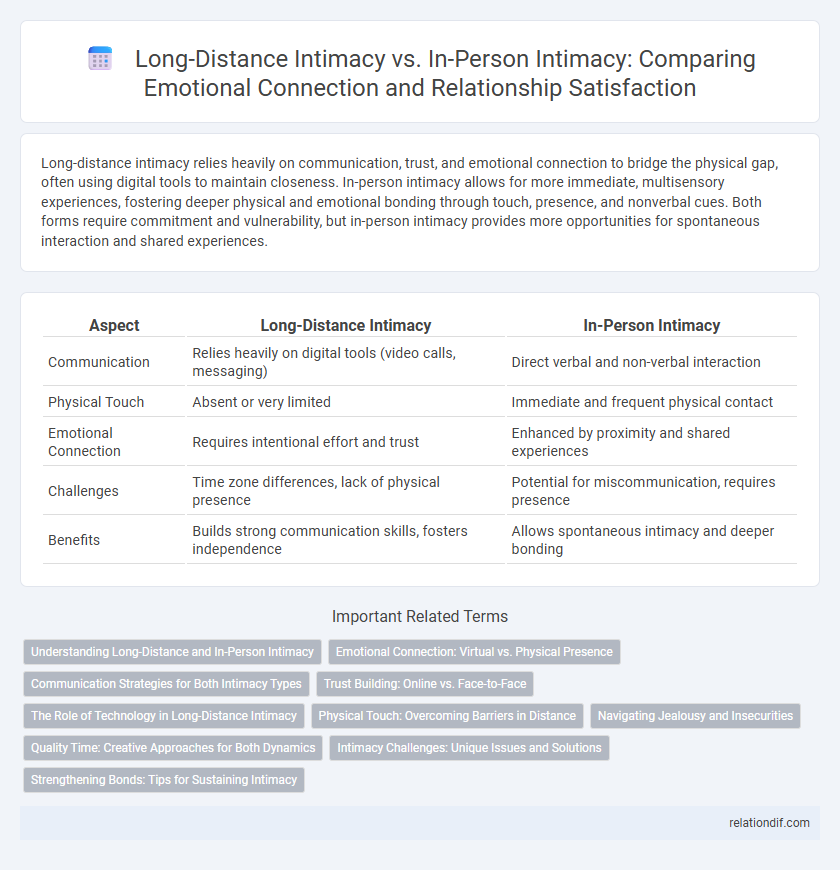Long-distance intimacy relies heavily on communication, trust, and emotional connection to bridge the physical gap, often using digital tools to maintain closeness. In-person intimacy allows for more immediate, multisensory experiences, fostering deeper physical and emotional bonding through touch, presence, and nonverbal cues. Both forms require commitment and vulnerability, but in-person intimacy provides more opportunities for spontaneous interaction and shared experiences.
Table of Comparison
| Aspect | Long-Distance Intimacy | In-Person Intimacy |
|---|---|---|
| Communication | Relies heavily on digital tools (video calls, messaging) | Direct verbal and non-verbal interaction |
| Physical Touch | Absent or very limited | Immediate and frequent physical contact |
| Emotional Connection | Requires intentional effort and trust | Enhanced by proximity and shared experiences |
| Challenges | Time zone differences, lack of physical presence | Potential for miscommunication, requires presence |
| Benefits | Builds strong communication skills, fosters independence | Allows spontaneous intimacy and deeper bonding |
Understanding Long-Distance and In-Person Intimacy
Long-distance intimacy relies heavily on communication technologies such as video calls, messaging, and virtual experiences to maintain emotional connection despite physical separation. In-person intimacy benefits from direct physical presence, enabling nonverbal cues, touch, and shared environments that deepen emotional bonds. Understanding these differences highlights the importance of trust, empathy, and intentional efforts in sustaining intimacy across varying distances.
Emotional Connection: Virtual vs. Physical Presence
Emotional connection in long-distance intimacy relies heavily on virtual communication methods like video calls, texts, and voice messages to maintain closeness despite physical separation. In-person intimacy benefits from physical presence, which enhances emotional bonding through non-verbal cues such as touch, eye contact, and shared environments. While virtual interactions require deliberate emotional expression, physical presence naturally fosters a deeper and more immediate emotional resonance.
Communication Strategies for Both Intimacy Types
Effective communication strategies for long-distance intimacy include regular video calls, expressive messaging, and scheduled check-ins to maintain emotional closeness despite physical separation. In-person intimacy benefits from nonverbal cues, physical touch, and shared activities that enhance bonding and mutual understanding. Both types require active listening, honesty, and emotional vulnerability to build trust and deepen connection.
Trust Building: Online vs. Face-to-Face
Trust building in long-distance intimacy relies heavily on consistent communication and digital transparency, fostering emotional closeness through video calls, messaging apps, and shared online activities. In-person intimacy facilitates trust through non-verbal cues, physical touch, and spontaneous interactions, which enhance emotional bonding and security. Both forms require mutual vulnerability and reliability, but face-to-face encounters generally accelerate trust development due to richer sensory experiences and immediate feedback.
The Role of Technology in Long-Distance Intimacy
Technology plays a crucial role in maintaining long-distance intimacy by enabling real-time communication through video calls, messaging apps, and virtual reality platforms. These tools facilitate emotional connection and intimacy despite physical separation, allowing couples to share experiences and express affection remotely. Advanced technologies, such as haptic feedback devices, further enhance sensory bonding by simulating touch, bridging the gap between digital interaction and physical presence.
Physical Touch: Overcoming Barriers in Distance
Physical touch plays a crucial role in intimacy, presenting a significant challenge for long-distance relationships where direct contact is impossible. Couples overcome these barriers by leveraging technology such as video calls and virtual reality to simulate closeness and maintain emotional connection. In-person intimacy benefits from spontaneous touch and physical presence, elements that long-distance partners must creatively replicate to sustain bonding.
Navigating Jealousy and Insecurities
Navigating jealousy and insecurities in long-distance intimacy requires clear, consistent communication and trust-building practices that counteract physical absence. In-person intimacy allows for immediate emotional cues and physical reassurance, which can quickly alleviate doubts and foster security. Both forms demand emotional honesty and active efforts to maintain connection, but long-distance relationships benefit from scheduled check-ins and transparent discussions to manage feelings of jealousy effectively.
Quality Time: Creative Approaches for Both Dynamics
Quality time in long-distance intimacy thrives through creative digital experiences such as virtual movie nights, online gaming, and synchronized meals, fostering emotional connection despite physical separation. In-person intimacy benefits from shared activities like cooking together, nature walks, or focused conversations, allowing for deeper emotional and physical bonding. Both dynamics require intentional presence and tailored activities to maximize meaningful interactions and sustain relational closeness.
Intimacy Challenges: Unique Issues and Solutions
Long-distance intimacy often faces challenges such as time zone differences, lack of physical presence, and limited non-verbal cues, leading to feelings of loneliness and miscommunication. In-person intimacy enables deeper emotional connection through physical touch, shared experiences, and immediate feedback, which fosters trust and security. Solutions for long-distance intimacy include scheduled virtual dates, honest communication, and creative use of technology to simulate closeness and maintain emotional bonding.
Strengthening Bonds: Tips for Sustaining Intimacy
Maintaining long-distance intimacy requires consistent communication, emotional vulnerability, and creative shared experiences to bridge physical gaps and sustain connection. In-person intimacy benefits from physical closeness and nonverbal cues, enhancing emotional bonds through touch and presence. Prioritizing trust, regular check-ins, and expressing appreciation strengthens intimacy in both settings, adapting to the unique demands of distance or proximity.
Long-distance intimacy vs in-person intimacy Infographic

 relationdif.com
relationdif.com